In the shadow of Vesuvius, I stumbled upon one of archaeology’s most haunting treasures. The boat houses of Herculaneum, uncovered in 1982, tell a tragic story of ancient Romans desperately seeking shelter from the volcanic fury that buried their city in 79 AD.
These seaside boatsheds, about 10 meters long, became the final refuge for around 300 people who hoped to escape the eruption by sea. That idea still chills me.
Walking through this site, I felt a sense of unease I haven’t experienced at other Roman ruins. Unlike Pompeii, which preserves daily life, Herculaneum’s boat houses capture humanity’s last stand in the face of disaster.
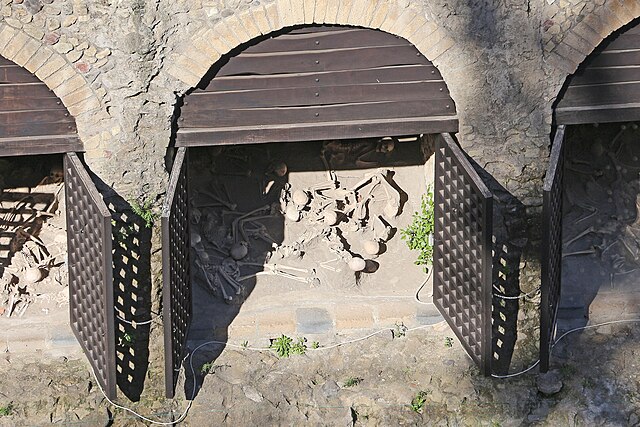
Image Source: Wikimedia Commons
The skeletons here (the ones you see now are replicas) show families huddled together, clutching their few possessions, waiting for rescue boats that never arrived.
My guide mentioned that most Herculaneum residents actually evacuated, so these remains stand out. They represent those who couldn’t flee in time – the last witnesses to one of history’s most infamous disasters.
If you visit, try to come early before the crowds gather. Take a moment in these spaces where the sea finally gave up its secrets after nearly two thousand years.
Unveiling the Boat Houses of Herculaneum
The boat houses of Herculaneum are one of archaeology’s most haunting finds. They offer a window into the final moments of hundreds who sought shelter from Vesuvius’s eruption in 79 AD.
Discovery and Excavation
I first heard about the boat houses during my 2023 visit to Herculaneum. These “fornici” (vaulted chambers) appeared along the ancient shoreline.
Unlike Pompeii, where excavations happened gradually, Herculaneum’s boat houses revealed their secrets all at once and with a certain drama.
When archaeologists opened these chambers in the 1980s, they found the skeletal remains of at least 300 people. These folks had fled to the fornici, hoping to escape the eruption.
Teams painstakingly removed layers of hardened volcanic material that had preserved the site for centuries. They didn’t just uncover architecture—they found a freeze-frame of human tragedy.
Structure and Function of the Fornici
Walking through Herculaneum now, I notice the design of these arched chambers built into the seawall. The fornici originally stored fishing boats and maritime gear—basically ancient boat garages.
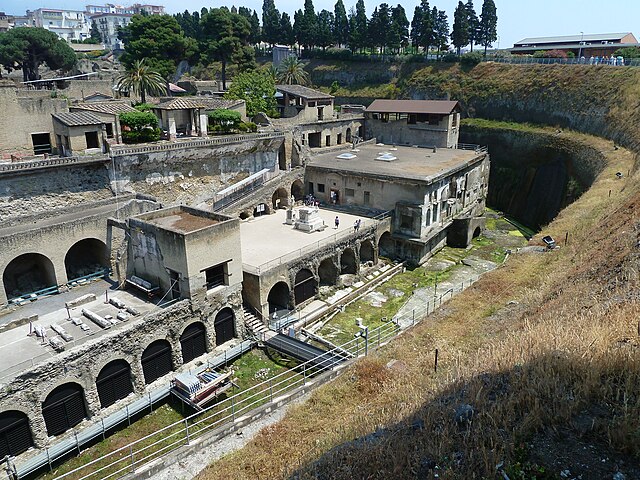
Image Source: Wikimedia Commons
The structures have high, vaulted ceilings and wide openings that once faced the sea. Roman concrete made them tough enough to withstand the eruption’s initial phases.
Archaeologists say fishermen and merchants also worked in these chambers. They found fishing nets, hooks, and other tools inside—evidence of bustling daily life in this coastal town.
The boat houses sat right on the ancient shoreline, though the coast now sits about 500 meters further out.
Andrew Wallace-Hadrill and Modern Research
Professor Andrew Wallace-Hadrill changed how we understand Herculaneum with his research. On my tour, I learned about his Herculaneum Conservation Project and its new approaches to studying the boat houses.
Wallace-Hadrill’s team uses DNA analysis and isotope testing on the skeletal remains. These studies uncovered details about the victims’ diets, health, and social status.
One surprising finding: many people who died in the boat houses weren’t the poorest, as once thought. Some wore jewelry and carried money, showing they were affluent residents fleeing with whatever they could grab.
Ongoing research keeps refining the timeline of the eruption. Scientists now think the victims died instantly from extreme heat—not slow suffocation.
The Last Moments: Herculaneum’s Victims in the Boat Houses
Finding nearly 300 skeletons in Herculaneum’s boat houses tells a heart-wrenching story of ancient Romans making a last, desperate bid to escape Mount Vesuvius’s wrath. These remains offer a powerful glimpse into their final moments as they waited for help that never came.
Skeletal Remains and Human Stories
As I walked among the boat houses near the old shoreline, I couldn’t ignore the sight of skeletons huddled together. Families and neighbors gathered here, hoping to flee by sea. They didn’t make it.
The “Ring Lady” stood out to me—she still wore beautiful gold rings on her fingers and gold bracelets, proof she was wealthy enough to grab her valuables before running.
Many bodies show that “boxing” position—arms raised up, a result of the intense heat contracting their muscles instantly. Men, women, and children lay together, telling stories of families who tried to escape as one.
The skeletons are so well preserved that researchers can figure out ages, health, and even family relationships.
Artifacts and Buried Treasures
Among the skeletons, I saw personal items that really drive home the panic of those last moments. Many victims carried small pouches with coins and jewelry—their most precious, portable things.
One man still gripped a soldier’s sword, maybe a family heirloom or his own weapon. The craftsmanship was shockingly good, even after centuries underground.
Wooden boxes with household treasures turned up next to some victims. They held everything from tiny statues to grooming tools.
What fascinates me most are the stories these items tell about Roman daily life. A child’s toy boat found near a young boy’s remains says so much about ordinary joys cut short.
Herculaneum’s unique burial conditions preserved organic materials incredibly well. I saw wooden furniture, fabric scraps, and even food that offer rare glimpses into Roman material culture.
Anthropological Insights
Looking at the victims’ teeth and bones, researchers found surprising details about Roman health and diet. Many Herculaneum residents ate a varied Mediterranean diet, especially seafood.

Anthropologists identified all sorts of occupations among the victims—fishermen, merchants, wealthy villa owners—all seeking refuge together. Disaster, it seems, erased social boundaries.
DNA analysis uncovered family connections among the dead. It’s moving to see scientific proof of mothers holding children and siblings together in their final moments.
The bones show fewer signs of malnutrition than you might expect, hinting that Herculaneum was pretty prosperous. Some skeletons even suggest these Romans were taller than Europeans who lived in the Middle Ages.
Patterns in the remains—from dental work to healed fractures—give us rare insights into ancient Roman medicine and the hazards of daily life.
The Cataclysm: Eruption of Mount Vesuvius and its Aftermath
The eruption of Mount Vesuvius in A.D. 79 stands out as one of history’s most devastating disasters. The volcano buried entire cities and forever changed the Bay of Naples.
Chronicle of A.D. 79: The Eruption Unfolds
On August 24, A.D. 79, Mount Vesuvius suddenly woke up after centuries of quiet. I’ve read Pliny the Younger’s accounts—he watched the eruption from across the bay and wrote letters that are still our best record of the disaster.
The day started with a column of smoke rising from the mountain. It grew into a massive, pine tree-shaped cloud, stretching nearly 20 miles high. Herculaneum’s residents had some time to flee, unlike their neighbors in Pompeii who faced danger much sooner.
By afternoon, things had gotten much worse. Darkness fell as volcanic ash blocked out the sun. Earthquakes rattled the ground, adding to the chaos.
Pyroclastic Flows and Hot Mud
The deadliest phase hit when the eruption column collapsed. This set off pyroclastic flows—superheated gas and volcanic debris moving at terrifying speeds, up to 100 mph.
The first surge slammed into Herculaneum within minutes. Instead of ash, Herculaneum was buried by hot mud and debris. This mix filled streets and buildings, then hardened into rock.
Evidence shows several pyroclastic surges buried the town deeper each time. In some places, volcanic material piled up as much as 75 feet thick.
Superheated Gases and Human Fatalities
The boat houses along Herculaneum’s shore held a grim secret. Archaeologists found over 300 skeletons there—people who’d hoped for rescue by sea.
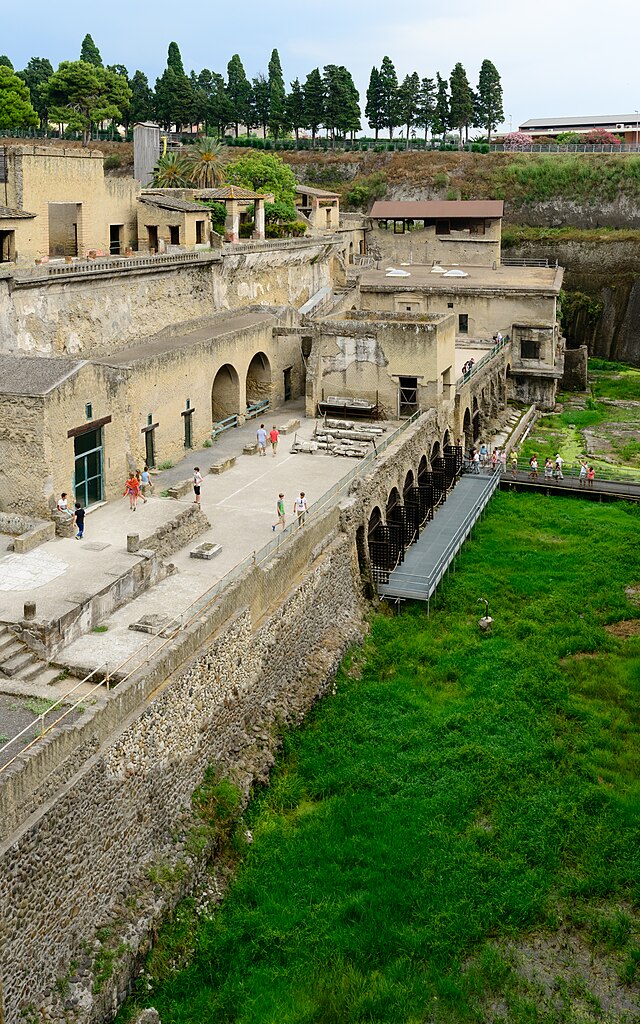
Image Source: Wikimedia Commons
Death came instantly. Superheated gas from the pyroclastic surge reached temperatures above 900°F, causing immediate thermal shock. Research even shows victims’ brain tissue vaporized and skulls exploded from boiling brain fluid.
These people didn’t drown in ash, as once believed—they died from extreme heat. Their final postures, arms raised defensively, show their last moments facing the blast.
The eruption pushed Herculaneum’s shoreline outward by nearly 1,300 feet, changing the landscape and burying the boat houses that now serve as eerie time capsules.
Life in Herculaneum Before Disaster Struck
Before Vesuvius erupted in 79 CE, Herculaneum thrived as a vibrant coastal town. The ruins reveal a lively community where Roman culture and architecture flourished, especially along its waterfront.
Daily Life and Social Fabric
Walking through ancient Herculaneum, I’m always struck by how familiar daily routines feel. The town had about 4,000-5,000 residents in a structured society typical of ancient Rome.
People started their days early, often visiting the public baths or grabbing breakfast at thermopolium (food stands).
The Decumanus Maximus, the main street, buzzed with shopping, gossip, and business. Wealthy folks handled affairs in the morning, then relaxed and bathed in the afternoon.
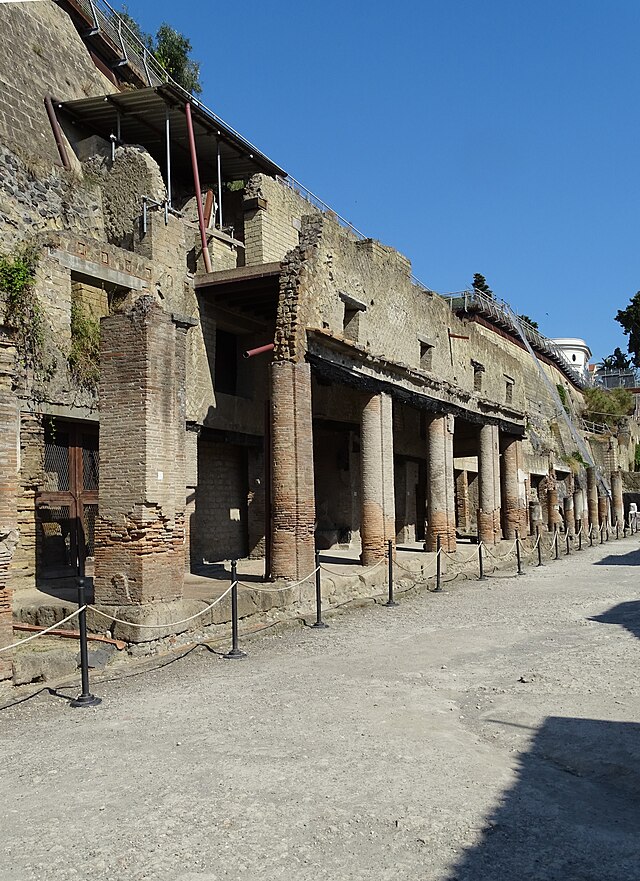
Image Source: Wikimedia Commons
Religious life centered around household shrines called lararia. Families made daily offerings, and the imperial cult played a big role, with festivals for the emperors.
Social classes were clear. Elite families lived in spacious villas with gardens, while workers and shopkeepers lived above their businesses in modest apartments.
Architecture and the Waterfront
The waterfront gave Herculaneum its unique charm. Unlike many Roman towns, Herculaneum featured terraced buildings that cascaded down to the sea.
I’m fascinated by the boathouses near the beach, where excavations uncovered hundreds of skeletons—residents who sought shelter during the eruption. These structures used carbonized wood beams, preserved thanks to the volcanic material.
The town boasted luxurious waterfront villas with stunning views of the Bay of Naples. These homes had multiple stories, colorful frescoes, and private baths—showing off their owners’ wealth.
Public buildings impressed too. The baths had advanced heating systems, and food shops featured counters with built-in containers for hot meals. The architecture blended Roman engineering with beauty, reflecting prosperity and a strong connection to the sea.
Archaeological Revelations and Ongoing Research
Excavating Herculaneum’s boat houses has delivered some of archaeology’s most important discoveries in recent decades. These structures keep revealing new insights into Roman maritime life and the city’s final hours when Vesuvius erupted.
Excavation Techniques and Conservation
Archaeologists found the boat houses during systematic digs that began in the 1980s. Herculaneum was buried under 20 meters of volcanic material, making excavation tough.
Teams developed specialized methods to remove hardened volcanic ash without harming fragile remains. They used microscopic tools and controlled environments to protect organic materials rarely found elsewhere.
Conservation efforts aim to prevent further decay from air and moisture. Scientists use climate-controlled chambers and protective coatings to preserve wooden beams and other artifacts.
I was amazed when I saw how they created plaster casts of voids left by decomposed wooden boats—a technique similar to Pompeii’s famous body casts, but for maritime gear.
Scientific Breakthroughs in Herculaneum Studies
The boat houses have totally changed how we see Roman maritime technology and coastal life. Researchers from around the world now study these remains using advanced tools.
DNA analysis of skeletons found in the boat houses revealed info about health, diet, and genetic backgrounds. A study in the New England Journal of Medicine even identified blood proteins preserved for nearly 2,000 years.
Phil Janney, a material scientist, developed dating techniques specifically for Herculaneum’s volcanic context. These methods allow for more precise timelines of the site’s use and abandonment.
3D modeling and virtual reality reconstructions now help visitors and researchers see how these structures looked before the eruption. These models highlight the sophisticated engineering behind the waterfront facilities.
Francesco Sirano and Future Prospects
Francesco Sirano, who directs the Herculaneum Archaeological Park, has taken a holistic approach to studying the boat houses. His “Herculaneum Past and Future” initiative blends conservation with public education.
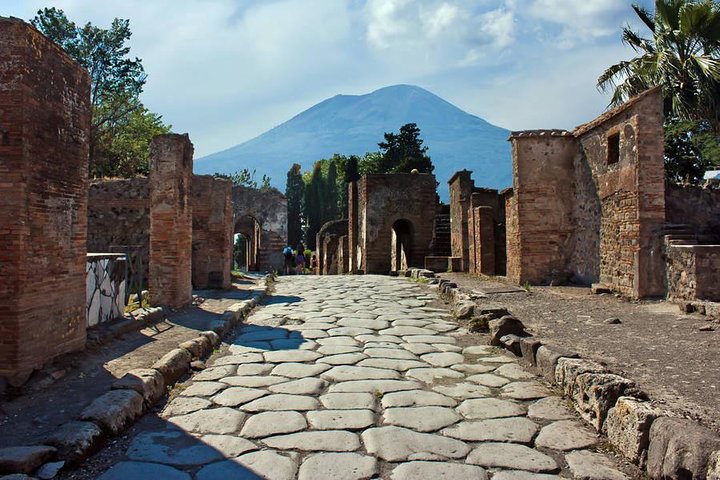
Image Source: Tripadvisor
Sirano’s team is carefully uncovering new waterfront areas. They document everything before moving materials, making sure nothing gets lost.
The Smithsonian Magazine recently spotlighted Sirano’s innovative work involving the local community in preservation. Residents now join educational programs and serve as site ambassadors.
Future research will dig deeper into the connection between the boat houses and the wider maritime economy of the Bay of Naples. Underwater surveys might uncover more structures hidden beneath today’s coastline.
Herculaneum in Context: Pompeii, Oplontis, and the Bay of Naples
The Bay of Naples was home to several thriving Roman towns, each with its own story when Vesuvius erupted in 79 CE. Though often overshadowed by Pompeii, Herculaneum offers different insights thanks to how well it’s been preserved.
Contrasts with Pompeii and Oplontis
Pompeii and Herculaneum share a tragic fate, but their differences are striking. While exploring Pompeii, I noticed its sprawling layout along the Sarno River Valley, which made it a key trading center. The city controlled routes for goods going inland.
Herculaneum was more compact and wealthier. The preservation is better too—Pompeii was covered in ash, but Herculaneum was sealed under pyroclastic flows that preserved organic material.
Oplontis, known for the Villa Poppea, shows off luxury villa life. Its gardens and frescoes reveal how the ultra-wealthy lived. While Herculaneum’s boat houses are all about function and tragedy, Oplontis is pure decoration and opulence.
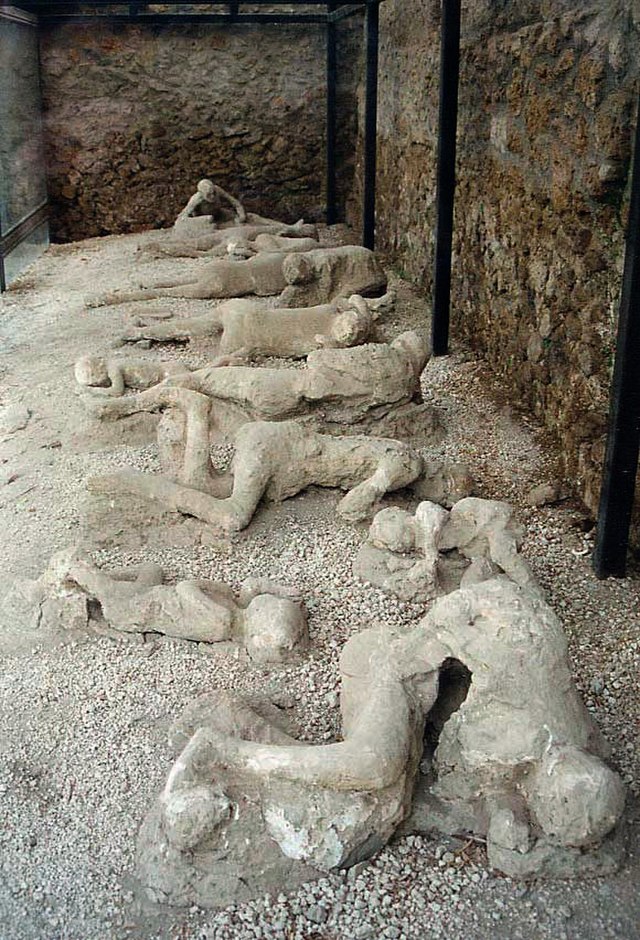
Image Source: Wikimedia Commons
The Garden of the Fugitives in Pompeii still haunts me—plaster casts of victims frozen in their final moments. Herculaneum’s boat houses, on the other hand, revealed skeletons of those who hoped for rescue by sea.
The Wider World: Bay of Naples and Roman Mysteries
The Bay of Naples was a bustling hub with safe anchorages and prosperous trading cities. Roman elites built villas along the shoreline for both business and pleasure.
Pliny the Elder died investigating the eruption, while his nephew, Pliny the Younger, documented it from across the bay. His letters gave us the first scientific description of a volcanic eruption.
Tacitus’s records add to the picture, describing life before the disaster—including the earthquake of 62 CE that weakened buildings ahead of the eruption.
I can’t help but wonder about the soldiers found at Herculaneum’s boat houses. Were they part of a rescue mission sent by Pliny? The discovery of a rescue ship nearby suggests organized evacuation attempts that, heartbreakingly, didn’t succeed.
And those distinctive phallic symbols all over these sites? They remind us of Roman attitudes toward fertility and protection—mysteries of daily life preserved right alongside the grand tragedy.


